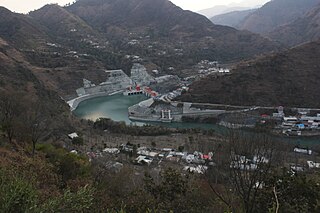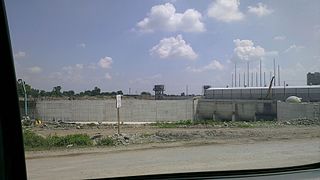
Tarbela Dam is an earth-filled dam along the Indus River in Pakistan's Khyber Pakhtunkhwa province. It is located mainly in the Swabi District Tehsil Topi of the province. It is about 20 km (10 mi) from the city of Swabi KPK, 105 km (65 mi) northwest of Islamabad, and 125 km (80 mi) east of Peshawar. It is the largest earth-filled dam in the world. The dam is 143 metres (470 ft) high above the riverbed and its reservoir, Tarbela Lake, has a surface area of approximately 250 square kilometres (97 sq mi).

The Neelum River, or Kishanganga River, is a river in the Kashmir region of Pakistan and India. It originates in Ganderbal district of Jammu and Kashmir in India, flows through the Neelam Valley in Pakistan's Azad Kashmir, where parts of its course fall along the Line of Control, before merging with the Jhelum River near the city of Muzaffarabad.

The Neelum–Jhelum Hydropower Plant is part of a run-of-the-river hydroelectric power project in Azad Kashmir (AJK) designed to divert water from the Neelum River to a power station on the Jhelum River. The power station is located 42 km (26 mi) south of Muzaffarabad, and has an installed capacity of 969 MW. Construction on the project began in 2008 after a Chinese consortium was awarded the construction contract in July 2007. After many years of delays, the first generator was commissioned in April 2018 and the entire project was completed in August 2018 when the fourth and last unit was synchronized with the national grid on 13 August and attained its maximum generation capacity of 969 MW on 14 August 2018. It will generate 5,150 GWh per year at the levelised tariff of Rs 13.50 per unit for 30 years.
The Kishanganga Hydroelectric Project is a run-of-the-river hydroelectric scheme in Jammu and Kashmir, India. Its dam diverts water from the Kishanganga River to a power plant in the Jhelum River basin. It is located near Dharmahama Village, 5 km (3 mi) north of Bandipore in the Kashmir valley and has an installed capacity of 330 MW.
The Khan Khwar Hydropower Plant is a run-of-the-river project located near the town of Besham in the Shangla District of the Khyber Pakhtunkhwa province of Pakistan. It is situated on the Khan Khwar River, a right bank tributary of the Indus River. It is approximately 265 km from the federal capital of Islamabad and 350 km from the provincial capital of Peshawar.
The Allai Khwar Hydropower Plant is a run-of-the-river, high head project of 687 metres, located in the Battagram District on the Allai Khwar River, a left bank tributary of the Indus River in Khyber Pakhtunkhwa province, Pakistan. It is approximately 245 km from the federal capital of Islamabad and 330 km from the provincial capital of Peshawar.
The Duber Khwar Hydropower Plant is located near the town of Pattan in Kohistan, Khyber Pakhtunkhwa, Pakistan on the Duber Khwar River, a right bank tributary of the Indus River. It is approximately 340 km NW from Islamabad, the federal capital of Pakistan.

Patrind Hydropower Plant is a run-of-the-river, high head project of 110 metres (360 ft), located on Kunhar River near Patrind Village right on the border of Abbottabad District of Khyber Pakhtunkhwa Province and Muzaffarabad city of Azad Kashmir, Pakistan. It is approximately 138 kilometres (86 mi) from Rawalpindi and Islamabad and about 76 kilometres (47 mi) from Abbottabad city.
Golen Gol Hydropower Plant (GGHPP) is a hydroelectric power plant located on the Golen Gol River - a major left tributary of Mastuj River in Chitral District of Khyber Pakhtunkhwa province of Pakistan. The dam is located approximately 25 km from Chitral city, and 365 km from the provincial capital of Peshawar. Construction of Golen Gol project began in 2011, and was completed in January 2018.
Shadiwal Hydropower Plant (SHPP) is a small, low-head hydroelectric generation station of 13.5 megawatt generation capacity (two units of 6.75 MW each), located near Gujrat city at Shadiwal 100 kilometer North-West of Lahore, Punjab province of Pakistan, on the flows of Upper Jhelum Canal. It is a small hydropower generating plant constructed and put in commercial operation in June 1961 with the Average Annual generating capacity of 42.67 million units of least expensive electricity.
Dargai (Malakand-II) Hydropower Plant (MHPP-II) is a small, low-head, run-of-the-river hydroelectric power generation station having about 20 megawatt generation capacity. It is located at the region of Dargai, Malakand within the province of Khyber Pajhtunkhwa, Pakistan. It is functions on the flow of the Swat River. It is about 210 km far from Pakistan's capital Islamabad and 45 km from the city of Mardan. It is a small hydel power generating plant constructed and put in commercial operation in December, 1952, generating an average annual yield of 162 million units (GWh) of much needed least expensive electricity.
The Dasu Dam is a large hydroelectric gravity dam currently under construction on the Indus River near Dasu in Kohistan District, Khyber Pakhtunkhwa Province, Pakistan. It is developed by Pakistan Water and Power Development Authority (Wapda), as a key component of the company's Water Vision 2025. The project was started in 2019 but faced a delay due to funds and land acquisition disputes. Work resumed in 2020 after land acquisition and arrangements of funding facility, the World Bank agreed to contribute $700 million of the $4.2 billion as the government of Imran Khan decided to proceed ahead with the construction of the project, as part of his vision of reducing Pakistan's reliance on non-renewable energy.
Gulpur Hydropower Plant (GHPP) is an operational run-of-the-river hydroelectric generation project located on Poonch River, a major tributary of Jhelum River near Gulpur in Kotli District of Azad Kashmir, Pakistan. The site is about 167 km from Federal Capital Islamabad and 285 kilometres (177 mi) from Punjab's Provincial Capital Lahore and is approachable directly from Islamabad and Lahore by a two-lane, all-weather, paved, partly mountainous road. The location of the project is about 28 km upstream of Mangla Dam Reservoir.
The Afulilo Dam is a gravity dam on the Afulilo River about 3 km (1.9 mi) south of Ta'elefaga in the district of Va'a-o-Fonoti on Upolu island of Samoa. The primary purpose of the dam is hydroelectric power generation and it supports a 4 megawatts (5,400 hp) power station. It is the largest hydroelectric power station by installed capacity in Samoa. First studied in 1980, construction on the project began in 1990 and the power station was commissioned in 1993. Funding for the US$26.6 million project was provided by the World Bank, Asian Development Bank, International Development Association, European Investment Bank, and European Economic Community loans and grants.

The New Bong Escape Hydropower Project is a privately owned 84 MW run-of-the-river project located on Jhelum River 7.5 km downstream of the 1,070 MW Mangla Dam, a major multi-purpose water storage project commissioned. It is about 120 km from Islamabad, the capital city of Pakistan. The project commenced commercial operations on 23 March, 2013 and has the distinction of being Pakistan and AJ&K’s first hydropower IPP. By developing a bankable framework this trendsetting project has paved the way for rapid and full scale development of Pakistan and AJ&K’s hydropower potential.

The Azad Pattan Hydropower Project is a 700.7 MW hydroelectric power station on the Jhelum River roughly 7 km upstream of Azad Pattan Bridge in the Sudhanoti District, Azad Jammu and Kashmir, Pakistan and 90 km from Islamabad, the capital city of Pakistan. The project is scheduled for completion by 2026. In July 2020, the project's $1.5 billion investment agreement was signed between Chinese state-owned China Gezhouba Group and Pakistan, in a ceremony attended by Prime Minister Imran Khan and senior government ministers.
SK Hydro also known as Suki Kinari HPP, is an under-construction, run-of-the-river hydropower project located on the Kunhar river in the Kaghan valley of Mansehra District Khyber Pakhtunkhwa, which has an installed generation capacity of 884 MW.
The Karot Hydropower Project is an asphalt-core rockfill gravity dam in Pakistan, with an installed capacity of 720 MW. The project is sponsored by Chinese state-owned company China Three Gorges Corporation (CTG).






